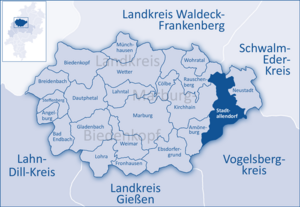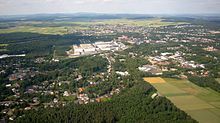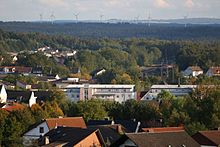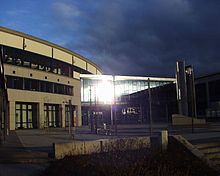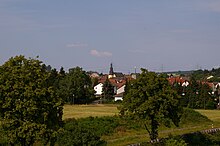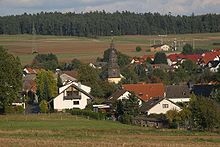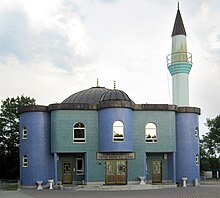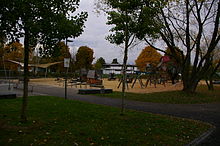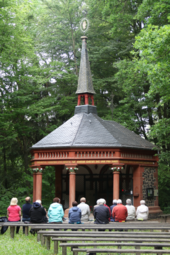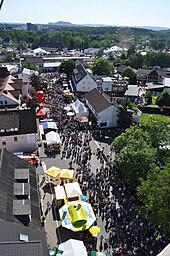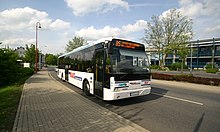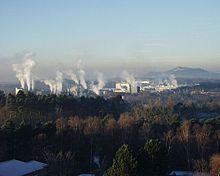Stadtallendorf
| coat of arms | Germany map | |
|---|---|---|
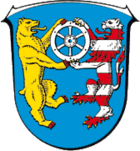
|
Coordinates: 50 ° 50 ' N , 9 ° 1' E |
|
| Basic data | ||
| State : | Hesse | |
| Administrative region : | to water | |
| County : | Marburg-Biedenkopf | |
| Height : | 256 m above sea level NHN | |
| Area : | 78.29 km 2 | |
| Residents: | 21,391 (Dec. 31, 2019) | |
| Population density : | 273 inhabitants per km 2 | |
| Postal code : | 35260 | |
| Primaries : | 06425 (Wolferode), 06428 (Erksdorf, Hatzbach), 06429 (Niederklein, Schweinsberg) | |
| License plate : | MR, BID | |
| Community key : | 06 5 34 018 | |
| LOCODE : | DE HSM | |
| City structure: | 6 districts | |
City administration address : |
Bahnhofstrasse 2 35260 Stadtallendorf |
|
| Website : | ||
| Mayor : | Christian Somogyi ( SPD ) | |
| Location of the city Stadtallendorf in the Marburg-Biedenkopf district | ||
Stadtallendorf is a town in the central Hessian district of Marburg-Biedenkopf, 18 kilometers east of Marburg .
geography
Geographical location
Stadtallendorf is located according to the natural spatial structure in the West Hessian depression zone , which is divided into basins and thresholds . In this regard, the city lies on the Upper Hessian Threshold , which separates the Amöneburg Basin in the west from the Schwalm Basin in the east. On this threshold is also the Neustädter Sattel , which the north-eastern outskirts of the city meets; this ridge is part of the Rhine-Weser watershed.
Around 21,600 people live in an area of 78.3 square kilometers. The largest north-south extension is 17.5 km, the largest east-west extension 10.38 km. The highest point is the Kohlkopf in the forest near Wolferode (371 m), the lowest point is at the Ohm near Schweinsberg with 200 m. The core city is about 250 m.
Several streams flow through Stadtallendorf and its districts, almost all of which drain via the Ohm , which itself only flows through the outskirts of the city ( Schweinsberg ). The Klein , one of the largest Ohm tributaries, runs on the edge of Niederklein . In the Stadtallendorf district there is also the source of the Wiera , which flows into the Schwalm and thus belongs to the river basin of the Weser. The Rhine-Weser watershed is close to the city limits of Neustadt .
Neighboring communities
Stadtallendorf borders in the north on the town of Rauschenberg (Marburg-Biedenkopf district) and the community Gilserberg ( Schwalm-Eder-Kreis ), in the east on the town of Neustadt , in the southeast on the town of Kirtorf , in the south on the town of Homberg (Ohm) ( both in the Vogelsberg district ), as well as in the west to the cities of Amöneburg and Kirchhain (both in the Marburg-Biedenkopf district).
City structure
- Stadtallendorf core town (about 16,900 inhabitants)
- Niederklein (about 1,700 inhabitants)
- Schweinsberg (an der Ohm) (about 1,100 inhabitants)
- Erksdorf , origin of the name comes from the original settler "Eric von Erkersdorp" (about 950 inhabitants)
- Hatzbach (about 550 inhabitants)
- Wolferode (about 450 inhabitants)
history
General story
The nucleus of today's city is the village of Allendorf, first mentioned in a document in 782 as “in villa, quae vocatur Berinscozo” (also called Allendorf in Bärenschießen ). Allendorf belonged to Kurmainz until 1802 and then fell to the Electorate of Hesse as a result of secularization . After the Prussian annexation of Kurhessen after the German War of 1866 , it belonged to the Kingdom of Prussia .
Until the end of the 1930s, Allendorf was a rural community with about 1,500 inhabitants. To distinguish it from other towns with the same name and because of the predominantly Catholic faith of its inhabitants, it was also called Catholic-Allendorf .
The beginning of the development into today's city marked the start of construction of two explosives factories in 1938. The two arms companies WASAG and DAG produced explosives here under great secrecy and filled them in bombs and grenades on site. During the Second World War, the two plants were the largest production facility for ammunition in Europe. Even today, some residential areas in Stadtallendorf are named after the armaments companies . The two explosives plants covered a total area of around 1,000 hectares and were located exclusively in the forest for reasons of camouflage against aerial reconnaissance. More than 15,000 forced laborers had to work in the armaments factories. Among other things , they were housed in the Münchmühle satellite camp , which belonged to the Buchenwald concentration camp . During the Second World War, the site was largely spared from Allied air raids . After the defeat of World War II, the US armed forces set up an internment camp for captured Wehrmacht generals in the workers' barracks of the armaments companies.
The approximately 600 hectare site of the former armaments factories was considered to be one of the largest old arms contamination in Germany, partly with high chemical pollution on residential properties. From 1991 the area was completely renovated. The renovation was officially declared over in March 2006. According to the Hessian Ministry of the Environment, the renovation cost 167 million euros. 154 tons of pollutants from the ground, 697 tons from a dump and three tons of explosive TNT were disposed of.
From 1945 to 1949 the armaments factories were dismantled. The approximately 400 vacant company buildings were retained. From 1948 industrial and commercial enterprises settled here. Allendorf subsequently developed into a typical displaced community . In 1960 the community, which had meanwhile grown to around 10,000 inhabitants, received city rights and the official name Stadt Allendorf . In 1977 the name was changed to Stadtallendorf .
Schweinsberg Castle from the 13th century is located in the Schweinsberg district and is now a residential complex. The remains of Waffensand Castle are located in the Niederklein district , and to the west of the city center was the Münchhausen settlement , which fell into desolation in the 15th century and which probably had a small fortified courtyard but no actual castle.
Incorporations
In the course of the regional reform in Hesse on December 31, 1971, the previously independent communities Erksdorf and Hatzbach and the city of Schweinsberg were incorporated . By state law, Niederklein and Wolferode were added on July 1, 1974.
Population development
(as of December 31st)
- 1998: 21,587
- 1999: 21,643
- 2000: 21,656
- 2001: 21,671
- 2002: 21,704
- 2003: 21,708
- 2004: 21,528
- 2012: 20,764
- 2016: 21,388
Around 20,700 people live in an area of 78.3 km², 16,900 of them in the city center. The proportion of foreigners in the core city is 25 percent.
religion
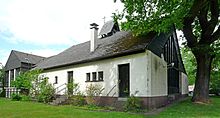
The origin of Stadtallendorf is the Catholic village Allendorf. Until shortly before the Second World War, Allendorf was popularly called "Catholic Allendorf" to distinguish it from numerous other places of the same name and had 1500 inhabitants. After the Second World War, religious relations changed due to the influx of many workers and displaced persons. Today there is also a large evangelical community. In Stadtallendorf, the proportion of foreigners is around 21% due to migration ; people from over 70 nations live there.
Catholic Church
Stadtallendorf belongs to the diocese of Fulda . The Catholic parish in the core town of Stadtallendorf has three churches (St. Katharina, Christkönig and St. Michael), which formerly formed their own parishes. Another independent Catholic parish existed in the district of Niederklein (St. Blasius and St. Elisabeth). Since January 1, 2016, as a result of the falling number of Catholics and the shortage of priests, all four parishes mentioned have been united under the umbrella of the new parish of the Holy Spirit. With a few other Catholic parishes in the area (Emsdorf, Momberg and Neustadt), the Catholic parish of Stadtallendorf forms the pastoral association Mariabild Stadtallendorf-Neustadt. This is named after the Mariabild forest chapel located in the Herrenwald between Stadtallendorf and Neustadt.
Protestant church
The Evangelical parish of Stadtallendorf is the largest in the Kirchhain parish with around 4800 members . At the same time, it is the sponsor of the only Protestant singing and music school in Germany that belongs to the " Association of German Music Schools ". 40 employees work primarily in the day-care center, the integrative after-school care center and the singing and music school. The municipality's budget is more than one million euros a year. The Protestant parish has two churches - the Herrenwald Church and the Protestant City Church. A “Diaspora Chapel” by the architect Otto Bartning , inaugurated under the name “Notkirche” in December 1952, is now used as a parish hall. Slightly changed by additions and modifications, it is in good condition. In 2013 the Herrenwaldkirche, built in 1965, was de-dedicated. There are other Protestant churches in the districts of Erksdorf , Hatzbach ( Hatzbach church ), Schweinsberg (Stephanskirche) and Wolferode .
Islam
Over 5,000 Muslims live in Stadtallendorf. The vast majority of Muslims are of Turkish origin. In Wupperweg there is the Fatih Mosque (Turkish Fatih Camii ), which belongs to the DITIB association and which was arson attacked in 2009. The founding of the Fatih Mosque goes back to an initiative by Turkish guest workers from the Fritz Winter iron foundry. In 1970, with donations from guest workers and with financial support from the management, the company had a barrack built on company premises in Weichselstrasse , which was used as a mosque for years. In the 1990s, the company moved to its current location, where a building and property were acquired by the mosque association. The new construction of the mosque with dome and minaret was completed in 2004.
In addition to the Fatih mosque, there are also mosques of the VIKZ and the IGMG . There is also a community of Alevis .
Judaism
In Stadtallendorf there was still a small Jewish community up until the Nazi era, the members of which emigrated or were deported and murdered during the Nazi regime. The Jewish cemetery on “Läuser Weg”, which has been preserved, still bears witness to this community.
politics
City Council
The local elections on March 6, 2016 produced the following results, compared to previous local elections:
| Parties and constituencies |
% 2016 |
Seats 2016 |
% 2011 |
Seats 2011 |
% 2006 |
Seats 2006 |
% 2001 |
Seats 2001 |
||
|---|---|---|---|---|---|---|---|---|---|---|
| CDU | Christian Democratic Union of Germany | 38.2 | 14th | 45.1 | 17th | 47.4 | 18th | 50.0 | 19th | |
| SPD | Social Democratic Party of Germany | 32.1 | 12 | 32.9 | 12 | 32.4 | 12 | 29.7 | 11 | |
| GREEN | Alliance 90 / The Greens | 6.7 | 2 | 10.2 | 4th | - | - | - | - | |
| FDP | Free Democratic Party | 9.8 | 4th | 6.3 | 2 | - | - | - | - | |
| BUS | Citizens Union Stadtallendorf | 13.3 | 5 | - | - | - | - | - | - | |
| REP | The Republicans | - | - | 5.6 | 2 | 7.1 | 3 | 9.1 | 3 | |
| AGS | Working group for local politics eV | - | - | - | - | 6.7 | 2 | 6.9 | 2 | |
| BB-FDP | Citizens' bloc - FDP | - | - | - | - | 6.4 | 2 | 4.3 | 2 | |
| total | 100.0 | 37 | 100.0 | 37 | 100.0 | 37 | 100.0 | 37 | ||
| Voter turnout in% | 39.8 | 41.6 | 41.9 | 52.5 | ||||||
mayor
Acting mayor since the early 1980s was the Christian Democrat Manfred Vollmer . He was the longest-serving mayor in the Marburg-Biedenkopf district and the first mayor of the city who was not elected by the city parliament, but directly by the citizens. His last term of office ended in March 2012. He left office for reasons of age. The SPD city councilor Christian Somogyi was elected as his successor on October 2, 2011 . He prevailed in the runoff election with 52.56 percent of the vote against Pierre Brandenstein (CDU). His term as mayor began on March 15, 2012. Somogyi resigned from his position as city councilor on December 31, 2011. The Social Democrat had already stood in the 2005 election, but had lost to the incumbent Vollmer at the time. In the mayoral election on September 24, 2017, he was re-elected with 68% of the votes cast.
coat of arms
The coat of arms was approved by the Hessian Ministry of the Interior on October 18, 1955.
| Blazon : "In blue a golden, red-armored bear and a lion, divided nine times by silver and red, holding up a silver, six-spoke wheel." | |
| Justification of the coat of arms: Hessian lion and wheel of Mainz mark the affiliation of the community: up to the secularization of the archbishopric of Mainz , then to Hesse. The bear alludes to the name "Allendorf im Bärenschießen", which the community used to distinguish it from other places with the same name. The coat of arms was retained even after the surrounding communities were incorporated into the city as part of the Hessian regional reform. |
Town twinning
Stadtallendorf has had partnerships with the English city of St Ives (Cambridgeshire) since 1989 and with the city of Coswig in Saxony-Anhalt since 1993.
Culture and sights
Parks and green spaces
Stadtallendorf calls itself "The young city in the country". Young, because the city has only had city rights since 1960. Green, because the city is located in the Herrenwald, a large forest area and there are also many green spaces in the city. The city only has structures that have grown in the old town, the other parts of the city have been laid out over the years and are criss-crossed by forest and spacious green areas. Between the Waldstrasse and the Main-Weser-Bahn is the Heinz-Lang-Park (formerly Volkspark), the largest inner-city green space. Two special attractions in the Heinz-Lang-Park are the “Pirate's Nest” playground for children and the skate park for young people.
The so-called Rathauspark is another larger park in the city center. There is next to the town hall pond also the memorial for the victims of the world wars.
nature
The Schweinsberger Moor nature reserve is located near the Schweinsberg district . It is considered the largest contiguous reed area in Central and Northern Hesse and is a retreat for many rare bird species.
Museums and memorials
The Documentation and Information Center (DIZ) Stadtallendorf is located at the construction site. The DIZ has been available to the public and especially schools as a memorial for the victims of National Socialism since autumn 1994. The authority is the magistrate. The DIZ is located in the side wing of the restored, listed building - formerly the administrative headquarters of Dynamit-Nobel AG. In a permanent exhibition, the eventful and extraordinary history of the town of Allendorf from the Weimar Republic to the 1950s is thematized, from the small farming village to the later industrial town. The focus of the presentation is on the period between 1933 and 1945, when Allendorf became a central location for armaments production for the Second World War. The special task of the DIZ is the processing and documentation of the situation of the forced laborers in the camps and explosives plants around Allendorf during this time.
The Münchmühle Memorial is located near the Stadtallendorfer Wasserwerk. It is reminiscent of the Münchmühle camp , a satellite camp of the Buchenwald concentration camp (near Weimar ). In stock Münch mill were from August 1944 to end of March 1945 1,000 women prisoners, mainly from Hungary , housed. They had to do forced labor for the explosives plants in Allendorf and Herrenwald .
The military history collection can be visited on the grounds of the Herrenwald barracks . It has been located in Stadtallendorf since 2008. Before that she was seen in the Ernst Moritz Arndt barracks in Neustadt (Hesse) . For reasons of space, the collection has had to be greatly reduced in size in recent years. Nowadays it only shows exhibits on the history of the Bundeswehr. Exhibits from the two world wars can no longer be exhibited, as can exhibits from the times of the National People's Army of the GDR.
In Wolferode there is the Sengelaub costume museum, which not only shows traditional costumes, but also many other exhibits, such as photos and dishes, from the history of the district.
Buildings
- Core city
There are many half-timbered houses in the old village. The oldest preserved (half-timbered) building is the "Alte Mainzer Kellerei". Its restoration was awarded the Hessian Monument Protection Prize in 2013 . The baroque church of St. Katharina is of particular importance in terms of art history. The building, which is also located in the old village, is one of the most beautiful baroque churches in Upper Hesse. There is a Marian grotto in the field at Allendorfer Höhe. It was built to thank Stadtallendorf for not being destroyed in the Second World War. In the DAG and WASAG districts there are still many testimonies from the time of National Socialism that are reminiscent of the Allendorf and Herrenwald explosives factories . The Plausdorf Castle is located on the far north-east edge of the Amöneburg district and is only 600 meters from the city limits of Stadtallendorf. It cannot be viewed from the inside as it is inhabited. Between Neustadt (Hessen) and the city center lies the small, historic-style chapel “Mariabild”. It is a popular pilgrimage destination.
The church of St. Blasius and Elisabeth in Niederklein is particularly worth seeing. Its main attractions include the Pieta, the Way of the Cross and the large cross from the 15th century. In addition, the church also has several relics, including a splinter from the cross of Jesus. There is also a Marian grotto in Niederklein. It is modeled on the grotto of Lourdes. Near the hamlet there are remains of the Castle Forest and the Castle Arms sand .
The townscape of Schweinsberg is still characterized by its numerous historical buildings. There are many preserved half-timbered buildings to be seen here, especially in the “Im Tal” street. The 15th century St. Stephen's Church is also worth a visit . On its outer wall is the gravestone of the lawyer , genealogist and pioneer of modern heraldry Johann Georg Estor, who was born in Schweinsberg . The castle of the Schenken zu Schweinsberg is the landmark of the district . It is still inhabited today and can therefore not be viewed from the inside.
In the district, both the church and the copies of the 5 virtues are worth seeing. The originals of the latter are in close proximity to the Elisabeth Church in Marburg.
City Hall
The town hall is located right next to the town hall, to which it is connected by a glazed corridor. It can accommodate up to 1200 people.
Sports
Stadtallendorf has an indoor and an outdoor pool. The largest sports hall in the city is the Herrenwaldhalle, which is operated by the Marburg-Biedenkopf district and in which the National German Table Tennis Championships took place in 1986 and 2005 . The Herrenwaldhalle was the first athletics hall in Hesse - but with an unusual track length of just 190 m. The Bärenbachhalle, the multi-purpose hall and the sports hall of the south school are also suitable for sports activities. Football matches and athletics events take place in the Herrenwaldstadion . There is an exercise trail in the northwest of the city.
A nationally successful sports club is TSV Eintracht Stadtallendorf , whose football department was promoted to the Regionalliga Südwest for the first time in 2017 .
The Hessentag 2010
The 50th Hessentag took place in Stadtallendorf from May 28 to June 6, 2010 . With almost 1.1 million visitors, it was one of the three best-attended Hesse days. The anniversary Hessentag was actually supposed to take place in neighboring Alsfeld , but the city gave up the organization for financial reasons. The Hessentag area stretched through the city center on both sides of the train station in Stadtallendorf, on one side through Waldstrasse to the large marquee in the Herrenwaldstadion, on the other hand through the city center via the town hall and city hall to the large car park in the northeast industrial area. Open-air concerts with up to 40,000 spectators with performances by the singer Pink on June 3, 2010, the band a-ha on June 6 and other musical greats also took place in the industrial park. The extensive state exhibition was on the new fairground on Herrenwaldstrasse and in parts of the Herrenwaldstadion. The Heinz-Lang-Park housed “nature on the trail”. The Herrenwaldhalle was used as the "Hessen Palace" for large hall events, and with additional stands there was space for 3,200 spectators.
Economy and Infrastructure
traffic
Highways
The most important connection to the Autobahn is the Homberg (Ohm) junction on Autobahn 5, 20 kilometers away . The Autobahn 49 currently ends about 25 kilometers away at Neuental - Bischhausen . It is to be further built past Stadtallendorf to Gemünden (Felda) (connection to the A5). The planning approval procedure for the first section to Schwalmstadt with connection to the B 454 has been completed, the financing has been approved and construction is already underway. The time of opening to traffic has not yet been determined. For Stadtallendorf, the two junctions Stadtallendorf-Nord / B 454 and Stadtallendorf-Süd are planned for further construction.
Federal highways
The federal highways B 62 and B 454 run through the urban area . The latter has been raised or lowered in sections since 2000 in order to remove all crossings at the same height.
railway station
Bus transport
Supported by the city and the tourist office, there is a city bus service with four lines. The city of Stadtallendorf is, besides Marburg, the only city with city bus routes in the Marburg-Biedenkopf district . The hourly lines stop at the bus station and ensure the connection of the station with the more remote city districts. Lines 91 and 92 are purely inner-city bus routes. Lines 85 and 90 also run largely through the city center, but also connect the southern (line 85) and northern (line 90) districts to the city center. There are also P + R and B + R spaces to the southwest of the station, which were expanded as part of the Hessentag. Additional parking spaces and bicycle parking spaces were built near the reception building, but they were only opened after the Hessentag at the end of 2010. There is also a taxi stop in front of the reception building. The current bus station was opened in 2009 because the old one, built in the early 1980s, had to give way to a new shopping center.
Biking and hiking trails
Numerous hiking and cycling trails lead through Stadtallendorf and the surrounding area. The most important are:
- The Elisabethpfad 2 and the Jakobsweg lead through Stadtallendorf.
- The “Forster Weg” hiking trail was laid out as a circular route through Stadtallendorf and the Herrenwald. It leads from the church of St. Katharina to the forest chapel "Mariabild" and back again. He passes numerous historical and religious testimonies from the history of the place (wayside shrines, St. Mary's grotto, etc.); This makes it a popular destination for both pilgrims and those interested in history.
- The 12 km long hiking trail “Rund um den Wetzstein” leads around the Wetzstein near the Hatzbach district.
- The GEO tour "Cross and Queer" leads as a circular route from the foot of the Amöneburg via Rüdigheim to the Schweinsberger Moor and then through the Ohm valley back to the starting point.
- The star trail from Marburg to the Hoherodskopf in Vogelsberg leads via Schweinsberg.
- A nature and fairy tale trail leads from Stadtallendorf to Neustadt / Hessen.
Companies

Several large factories such as Ferrero GmbH (confectionery), Fritz Winter Eisengießerei GmbH & Co. KG and Hoppe AG (window and door handle manufacture) are located in Stadtallendorf . Kuehne + Nagel has a branch in Stadtallendorf . The nationwide family company Gies Services has its headquarters in Stadtallendorf . The city is the economic center of the eastern district of Marburg-Biedenkopf and its industrial center. It offers over 12,000 jobs. The trade taxes paid by the companies make up an average of around 70 percent of the city's tax revenue.
garrison
Since 1959 there have been two Bundeswehr barracks in Stadtallendorf , the Herrenwald barracks and the Hessen barracks , which were most recently largely empty. The latter should originally have been closed until 2018 because it only served as an alternative quarters for the soldiers affected by the renovation work in the Herrenwald barracks. It is planned that the Hessen barracks will receive new buildings, and Bundeswehr units are to be relocated there. 100 million euros are to be invested in the new building measures. The headquarters and the airborne communications battalion of the Rapid Forces Division are stationed in the Herrenwald barracks . Since 1966 Stadtallendorf was also home to the observing / reconnaissance artillery . The observation battalion 23 was disbanded in 1993 with the exception of one battery and this was incorporated as an independent battery into the 70th artillery regiment in Mühlhausen . It last traded as the 7th / observation tank artillery battalion 131 and was finally dissolved at the end of 2009.
media
In Stadtallendorf, the Marburg-based daily Oberhessische Presse maintains a local editorial office. The editorial office in Stadtallendorf is on Am Hallenbad. In addition, the Mittelhessische Werbung Zeitung (MAZ) and the Sunday morning magazine are distributed free of charge. Both sheets are ad-financed free newspapers . The city publishes the bear messenger, which contains news from the clubs and notices from the administration. The bear messenger is distributed to all households in the city center and the districts on Wednesdays.
A local edition of the Marburger Neue Zeitung was published by October 1, 2010 . However, this was discontinued for economic reasons.
education
The largest school in the city is the Georg Büchner School near the town hall with around 900 students. It is a cooperative comprehensive school . In addition, there are elementary schools in the city center (Bärenbach-, Nord-, Süd- and Waldschule) and in all districts except Wolferode. In the city center there are two independent special schools with 50 and 100 pupils, respectively, as well as a library, the Astrid Lindgren School and the Landgravine Elisabeth School. The Adult Education Center Marburg-Biedenkopf also operates a branch in Stadtallendorf.
Personalities
sons and daughters of the town
- Johann Georg Estor (1699–1773), lawyer and genealogist, born in Schweinsberg
- Hans Caspar von Knoblauch zu Hatzbach (1719–1793), Major General in Hesse-Kassel, born in Hatzbach
- Franz Heinrich Meinolf Wilhelm (1725–1794), physician and university professor, born in Niederklein
- Johann Ludwig Koch (1772–1853), clergyman, politician, canon lawyer and librarian, born in Niederklein
- Rudolph Schenck zu Schweinsberg (1855–1911), German administrative and court official and parliamentarian, born in Schweinsberg, buried in the family cemetery of Schenken zu Schweinsberg in Schweinsberg
- Heinrich Hohl (1900–1968), farmer, member of the Bundestag, politician ( CNBL , later CDU ) and mayor of the formerly independent municipality of Erksdorf, born in Erksdorf
- Karlheinz Spielmann (1908–1980), lawyer, lieutenant in the air force, business leader and honorary representative of citizen interests, born in Schweinsberg
- Theo Gutberlet (1913–1994), entrepreneur and founder of the food retailer Tegut , born in Schweinsberg
- Wigbert Wicker (* 1939), director and screenwriter from Car-napping, among others: Ordered - stolen - delivered, Didi in full swing, Derrick and Der Bulle von Tölz
- Frauke Nahrgang (* 1951), children's book author from the Teufelskicker series, among others
- Peter Bellendir (1955–2013), drummer from Xmal Germany , among others
- Eike Immel (* 1960), former national soccer goalkeeper
Personalities who have worked in Stadtallendorf
- Johann Schenk zu Schweinsberg (1460–1506), Hessian nobleman , landgrave-Hessian marshal , imperial councilor and knight of the Holy Sepulcher , had Schweinsberg Castle expanded in 1482
- Baron Ferdinand Schenck zu Schweinsberg (1765–1842), Minister of Justice of the first government under the constitution of 1831 in Kurhessen , died at Schweinsberg Castle , buried in the family cemetery of the Schweinsberg taverns in Schweinsberg
- Baron Wilhelm Schenck zu Schweinsberg (1809–1867), former head of government of Hohenzollern-Sigmaringen and former director of the Hessian Foreign Ministry, died in Schweinsberg
- Éva Pusztai-Fahidi (* 1925), Hungarian contemporary witness, author, Holocaust survivor and honorary citizen of Stadtallendorf, made forced labor for explosive works Allendorf and Herrenwald in sub-camp Münch mill of the concentration camp of Buchenwald , when the war ended in 1945 she was in a death march to flee
- Wilfried Härle (* 1941), Protestant theologian, lived in Stadtallendorf
- Gottfried von Knoblauch zu Hatzbach (* 1947), President of the Hesse State Medical Association since August 30, 2008, ran a medical practice in Stadtallendorf
- Angelo Bonafede (* 1950), Mr. Italia 1978, resident in Stadtallendorf-Erksdorf
- Volker Bescht (* 1951), retired Brigadier General D. of the army of the Bundeswehr and former deputy commander of the special operations division in Stadtallendorf
- Dieter Gruner (* 1953), journalist, author and former head of the OR editorial team in Stadtallendorf
- Wolfgang Schräder (* 1955), former rallycross driver and first German rallycross champion, lives in Stadtallendorf
- Christian Somogyi (* 1956), politician (SPD) and mayor of Stadtallendorf since 2012, lives in Niederklein
- Margot Käßmann (* 1958), Protestant theologian and former bishop, grew up in Stadtallendorf
- Michael Wehrheim (1959–2011), economist and table tennis player, played in the regional league for TTV Stadtallendorf
- Jürgen Wagner (proper name: Open! Open !; * 1964), theologian, became known as a dropout, “forest man” and founder of the “Givers or Gift Movement” , living in Stadtallendorf
- Marcos Lopez (* 1966), DJ, radio presenter and music journalist, grew up in Stadtallendorf
- Jürgen Losekam (* 1966), former soccer player at Mainz 05, Eintracht Braunschweig, SC Neukirchen and TSV Eintracht Stadtallendorf and soccer coach, grew up in Hatzbach
- Carsten Knobel (* 1969), board member at Henkel , grew up in Stadtallendorf
- Sven Dajczak aka Bruda Sven (* 1973), rap musician, grew up in Stadtallendorf
- Helmar Willi Weitzel (* 1972), TV presenter, grew up in Stadtallendorf
- Handan Özgüven (* 1973) politician (SPD) and member of the state parliament of Hesse, lives in Stadtallendorf
- Anika Decker (* 1975), screenwriter a. a. von Keinohrhasen , Zweiohrküken and Rubbeldiekatz , grew up in Stadtallendorf
- Sultan Tunc (* 1976 as Recep Tunç), rapper, grew up in Stadtallendorf
- Claudius Weber (* 1978), soccer player, played for TSV Eintracht Stadtallendorf in the Hessenliga
- Daniel Vier (* 1982), soccer player, played for TSV Eintracht Stadtallendorf
- Johannes Österling (* 1983), former swimmer and substitute candidate at the 2004 Summer Olympics in Athens, grew up in Stadtallendorf
- Steffen A. Korell (* 1984), lawyer, mayor of the city of Gersfeld (Rhön) , grew up in Stadtallendorf
- Christin Deuker (* 1986), singer, actress at the Ohnsorg Theater and a member of the ensemble of the “Malente family”, grew up in Stadtallendorf
- Jan Michael Schaub (* 1990), marksman and participant in the 2012 Paralympic Summer Games in London, grew up in Stadtallendorf
- Victoria Bieneck (* 1991), beach volleyball player, including U-23 World Champion 2013, grew up in Schweinsberg
- Kevin Strangmeyer (* 2000), basketball player
literature
- Magistrate of the City of Stadtallendorf (Ed.): 1200 years Stadtallendorf 782–1982 , Stadtallendorf 1982
Web links
- Website of the city of Stadtallendorf
- Website of the documentation and information center Stadtallendorf
- Stadtallendorf, Marburg-Biedenkopf district. Historical local dictionary for Hessen. In: Landesgeschichtliches Informationssystem Hessen (LAGIS).
- Stadtallendorf. Search in "Historical image documents from Hessen". In: Landesgeschichtliches Informationssystem Hessen (LAGIS).
Individual evidence
- ↑ Hessian State Statistical Office: Population status on December 31, 2019 (districts and urban districts as well as municipalities, population figures based on the 2011 census) ( help ).
- ↑ Document book of the Reichsabtei Hersfeld, Marburg 1936, p. 30
- ↑ Chern Chen: The Allendorf stone camp. On the history of the POW camps of German generals after the Second World War. In ZHG 120, the Association for History and Regional Studies (VHG)
- ↑ Law on the reorganization of the Biedenkopf and Marburg districts and the city of Marburg (Lahn) (GVBl. II 330-27) of March 12, 1974 . In: The Hessian Minister of the Interior (ed.): Law and Ordinance Gazette for the State of Hesse . 1974 No. 9 , p. 154 , § 8 ( online at the information system of the Hessian state parliament [PDF; 3.0 MB ]).
- ^ Federal Statistical Office (ed.): Historical municipality directory for the Federal Republic of Germany. Name, border and key number changes in municipalities, counties and administrative districts from May 27, 1970 to December 31, 1982 . W. Kohlhammer, Stuttgart / Mainz 1983, ISBN 3-17-003263-1 , p. 402-404 .
- ↑ a b Frankfurter Rundschau of May 27, 2010: Stadtallendorf. Multi-ethnic city in the country
- ↑ Diocese of Fulda ( Memento from September 3, 2015 in the web archive archive.today )
- ↑ Pastoralverbund Maria image Stadtallendorf-Neustadt
- ↑ Ev. Stadtallendorf Church ( Memento from December 13, 2014 in the Internet Archive )
- ^ My home: Stadtallendorf, Herrenwaldkirche
- ↑ DITIB - Turkish-Islamic Union of the Institute for Religion eV / regional associations
- ↑ Der Spiegel from November 23, 1975: A tubular steel tower as a minaret
- ↑ Der Spiegel of July 30, 1973: The Turks are coming - save yourself if you can
- ↑ Panoramio: Ruins of the first mosque in Stadtallendorf
- ↑ HNA of May 31, 2010: In the still young Stadtallendorf every fourth person has a foreign passport. Multiculturalism with a mosque
- ^ Association of Islamic Cultural Centers
- ^ Mosque list 2015
- ↑ Documentation and Information Center Stadtallendorf ( Memento of the original dated September 23, 2015 in the Internet Archive ) Info: The archive link was automatically inserted and not yet checked. Please check the original and archive link according to the instructions and then remove this notice.
- ^ Alemannia Judaica: Stadtallendorf
- ^ Result of the municipal election on March 6, 2016. Hessian State Statistical Office, accessed in April 2016 .
- ^ Hessian State Statistical Office: Result of the municipal elections on March 27, 2011
- ^ Hessian State Statistical Office: Result of the municipal elections on March 26, 2006
- ↑ Oberhessische Presse of January 21, 2016: The “Bürger Union Stadtallendorf” (BUS) around the former republican Manfred Thierau is running for the first time in the local elections.
- ↑ Results of the mayoral elections 2005 and 2011 , Stadt Stadtallendorf. Retrieved March 2, 2012.
- ↑ Direct elections in Stadtallendorf, Stadt. Hessian State Statistical Office , accessed in January 2019 .
- ↑ Approval of a coat of arms of the community of Allendorf, district of Marburg, administrative district of Kassel from October 18, 1955 . In: The Hessian Minister of the Interior (ed.): State Gazette for the State of Hesse. 1955 no. 45 , p. 1115 , point 1159 ( online at the information system of the Hessian state parliament [PDF; 2.8 MB ]).
- ↑ Internet pages of the city
- ↑ Documentation and Information Center Stadtallendorf
- ↑ Münchmühle, concentration camp satellite camp. Topography of National Socialism in Hesse. In: Landesgeschichtliches Informationssystem Hessen (LAGIS).
- ^ Michael Rinde: Bundeswehr location: new building should solve several problems. In: Oberhessische Presse online. October 22, 2014.
- ↑ Sengelaub costume museum
- ↑ Hessian Monument Protection Prize 2013 (pdf)
- ↑ Sankt Katharina ( Memento from May 3, 2015 in the web archive archive.today )
- ^ Mariengrotte ( Memento from May 3, 2015 in the web archive archive.today )
- ↑ Forest Chapel ( Memento from May 3, 2015 in the web archive archive.today )
- ↑ St. Blasius and St. Elisabeth. Stadtallendorf Catholic Church, accessed on August 15, 2018 .
- ^ Mariengrotte Niederklein. In: Internet presence. Stadtallendorf, accessed on August 15, 2018 .
- ↑ The 5 Virtues. In: Internet presence. Stadtallemdorf, accessed on August 15, 2018 .
- ↑ Stadtallendorf town hall
- ↑ Fest der Hessen: Vellmar no longer wants to host the 2013 event - Hessentag turbulence doesn't bother Bensheim , hr-online.de
- ↑ Pink comes to Stadtallendorf , Oberhessische Presse
- ^ Official website of the Hessentag 2010 ( Memento from April 30, 2011 in the Internet Archive )
- ↑ OP special: Jubiläumshessentag ( memento from December 29, 2010 in the Internet Archive ), Oberhessische Presse
- ^ Stadtallendorf am Jakobsweg and Elisabethpfad 2. In: Internet presence. Stadtallendorf, accessed on August 15, 2018 .
- ↑ Forster Weg circular route. In: Internet presence. Stadtallemdorf, accessed on August 15, 2018 .
- ↑ GEO tour “Kreuz und Quer”. In: Internet presence. City of Amöneburg, accessed on August 15, 2018 .
- ↑ On the Sternweg to the Hoherodskopf. In: http://www.vogelsberg-touristik.de . Vogelsberg-Touristik, archived from the original on October 11, 2016 ; accessed in August 2018 .
- ↑ Not a fairy tale: The fairy tale trail is ready. In: online edition. Oberhessische Presse, accessed in August 2018 .
- ↑ Oberhessische Presse of June 1, 2012: Stadtallendorf location. Division gets a strong staff
- ↑ bundeswehr.de of September 18, 2015: Closures in Hesse
- ↑ Oberhessische Presse of June 14, 2012: Bundeswehr barracks. "Grace period" helps troops and cities
- ^ Hessenkaserne: First demolition, then new building , op-marburg.de, October 11, 2019
- ↑ Awarded the flag ribbon by Volker Bouffier on the occasion of five years of DSK 100 million for the "Hessenkaserne" , oberhessen-live.de, September 8, 2019
- ↑ Observation Battalion 23
- ^ " The last local edition - Marburger Neue Zeitung is discontinued" , in: MZeitungssterben - From the end of printed newspapers , September 29, 2010
- ↑ Schools in the Marburg-Biedenkopf district ( Memento from August 4, 2012 in the web archive archive.today )
- ↑ Education. In: Internet presence. City of Stadtallendorf, accessed on August 15, 2018 .
- ↑ Derrick Fan Club
- ↑ Mr. Italia ( Memento from February 13, 2014 in the web archive archive.today )
- ^ MSC Stadtallendorf
- ^ German General Sunday Gazette, June 11, 1999, No. 24/1999 ( Memento of July 16, 2002 in the Internet Archive )
- ↑ transfer market: Jürgen Losekam
- ↑ weltfussball.de: Jürgen Losekam
- ^ Frankfurter Allgemeine, April 14, 2012: Screenwriter Anika Decker. The twelve million woman
- ↑ Mittelhessen.de on May 23, 2009: Child of the water paws dry
- ↑ Over two hours of fun - Christin Deuker and the Malente family make the audience laugh ( Memento from February 22, 2014 in the Internet Archive )
- ↑ Homepage Christin Deuker
- ↑ Oberhessische Presse of September 4, 2012: Paralympics 2012. Stadtallendorfer Schütze is the best German

